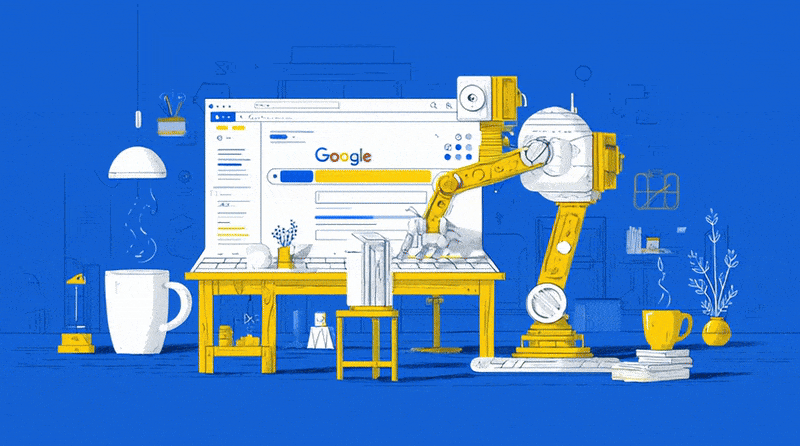-
 Published: Jul 30, 2025
Published: Jul 30, 2025
-
 18 min. read
18 min. read
-
Summarize in ChatGPT
-
 Trevin Shirey
Trevin Shirey VP of Marketing
VP of Marketing
- Trevin serves as the VP of Marketing at WebFX. He has worked on over 450 marketing campaigns and has been building websites for over 25 years. His work has been featured by Search Engine Land, USA Today, Fast Company and Inc. Read his review of working with WebFX for the last 15 years.
Table of Contents
- The three AI Overview accelerators
- The two AI Overview brakes
- High-risk query patterns: Where AI Overviews dominate
- Safe zone query patterns: Where traditional results dominate
- What AI overviews eating your traffic means for your marketing strategy
- Implications for SEO as a marketing channel
- Methodology and data considerations
Key takeaways from our study of 2.37m keywords
- AI Overviews now appear in 1 of every 4 US searches and shoot past 50% when a query reaches seven words or longer.
- Three accelerators (long queries, informational intent, trust‑heavy verticals) raise AI Overview likelihood, while two brakes (local/brand modifiers and visual‑commerce terms) sharply cut it.
- AI Overview likelihood swings wildly by industry: health, finance, jobs/education, and family topics top 50% AI Overview rates, whereas visually driven verticals like apparel sit near 12%.
“Come gather ’round, people, wherever you roam, and admit that the waters around you have grown…” – Bob Dylan
Search marketers can feel those rising waters as Google’s AI Overviews continue to flood the results pages in 2025. Pressured by LLM rivals like ChatGPT and users who expect instant answers, Google’s response is simple: Show the answer itself in the search results as often as possible.
How often? 25.8 % of 2.37 million US queries we analyzed surfaced an AI Overview box. We’ve spent time crunching the data to understand exactly where, when, and why Google’s AI Overviews appear. The results reveal that getting answers instead of website visits is rapidly becoming the new normal for certain types of searches.
Three accelerators – long queries, informational intent, trust‑heavy industries – push the odds of an AI Overview up. And we also found two factors that drastically reduce the likelihood of AI overviews: local or brand modifiers and visual commerce queries.
The current state: 1 in 4 searches already include AI Overviews
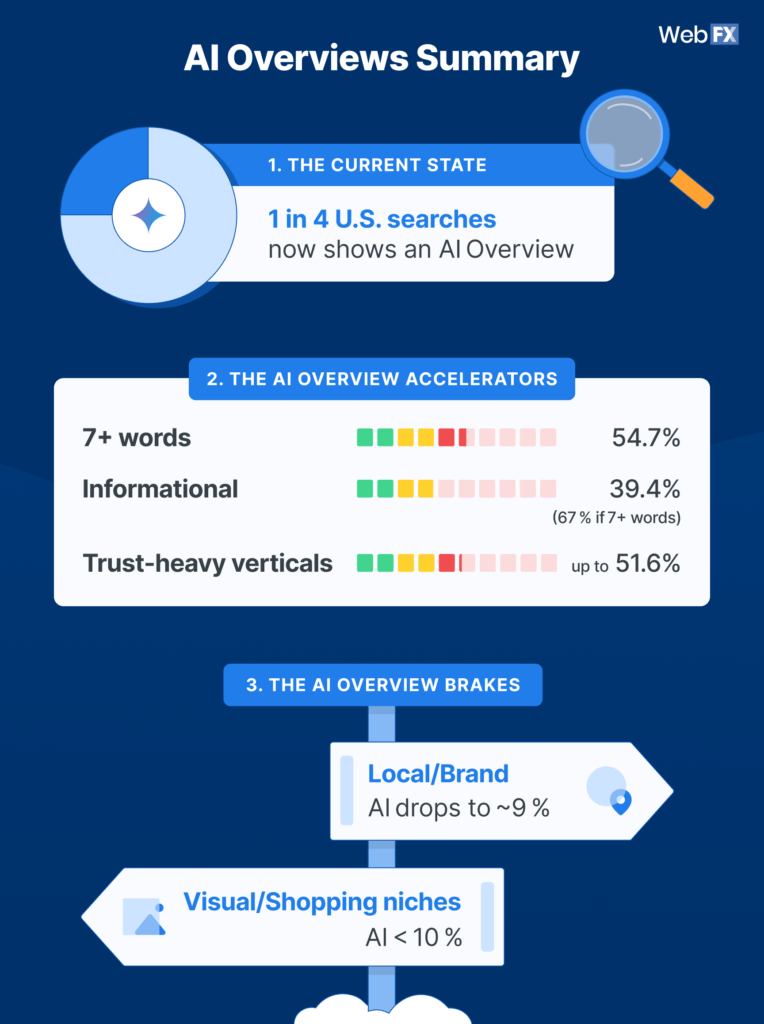
But here’s some good news in a sea of uncertainty: AI Overviews follow predictable patterns. They’re not randomly scattered across search results like confetti. Instead, they cluster around specific query characteristics, search intents, and industry verticals in ways that savvy marketers can both anticipate and, in some cases, avoid. And this is true across different industries as well. For example, manufacturing AI Overviews will also follow patterns.
Understanding these patterns means you can audit your keyword portfolio, identify your highest-risk terms, and develop strategies that work with AI Overviews rather than simply hoping they don’t affect your traffic.
The broader implications become clear when you consider search volume distribution. While 25.8% might sound manageable, that percentage represents millions of daily searches where traditional organic results now compete with AI-generated answers. For businesses relying on informational content to drive awareness and establish expertise, this represents a sizeable shift in how users discover and consume information.
The three AI Overview accelerators
Accelerator #1: Query length creates the danger zone
The relationship between query length and AI Overview likelihood paints a clear picture and if you have a lot of informational content on your site that’s traditionally performed well in organic search, you should pay special attention.
| Word Length | AI Overview Rate | Notable Insights |
| 1-2 words | 19.6% | One word health terms like “eczema” can hit 50% |
| 3-4 words | 24.1% | Baseline rate |
| 5-6 | 33.6% | “How to fix…” DIY queries |
| 7+ words | 54.7% | 65.9% if an informational query |
There’s a tipping point here: once a query hits seven words or more, you’re essentially flipping a coin. AI Overviews appear in more than half of all results. For informational queries that are 7+ words, that number jumps to 65.9%. Ouch.
What makes this particularly challenging for content marketers is that longer queries typically represent more specific, high-intent searches. This is the bread and butter of a lot of content marketing strategies, as these types of queries typically drive a lot of search volume from high-intent users.

Let’s look at an example of query length at play. Consider the difference between “plumbing repair” (2 words, 19.6% AI rate) and “how to fix a leaking bathroom faucet without calling a plumber” (11 words, likely 65%+ AI Overview rate). The longer query represents someone looking for specific information and would traditionally come over to a website with an informational tutorial or video on how to DIY fix a leaking faucet. Now, much of this traffic is eaten up by the AI Overview.
Accelerator #2: Informational intent faces the highest risk
Another key accelerator of AI Overviews lies in the intent behind the search…what the searcher is after.
| Search Intent | AI Overview Rate (All Lengths) | AI Overview Rate (7+ Words) |
| Informational | 39.4% | 65.9% |
| Commercial | 22.2% | 46.1% |
| Transactional | 16.5% | 31.8% |
| Navigational | 12.0% | 23.1% |
Google’s view seems to be this: AI Overviews are most helpful for informational queries and provide a better user experience than traditional search results in many instances. Informational queries like the “how do I,” “what is,” and “why does” searches that traditionally drove traffic to educational content face nearly double the AI Overview rate of transactional queries.
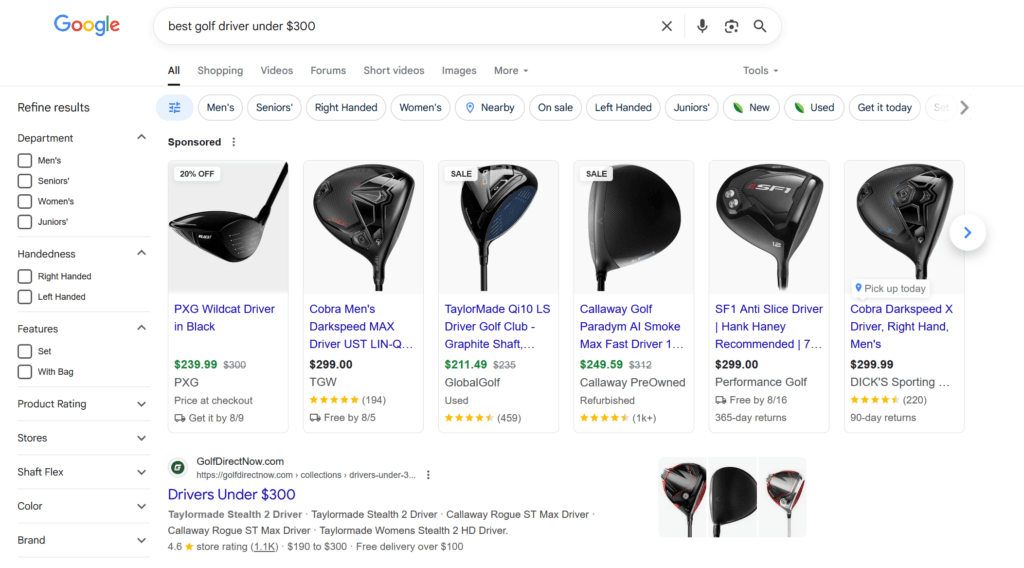
A skeptic would also notice that Google appears to be at least semi-preserving the commercial search experience where money changes hands. Transactional queries, which drive ecommerce revenue and lead generation, maintain relatively lower AI Overview rates. Google recognizes that completely disrupting the purchase funnel would damage advertiser relationships and revenue streams through SERP features like Google Ads and Google Shopping. So if you search “best golf driver under $300” you are likely to get Shopping results instead of AI Overviews offering tips for finding the best driver for your golf game.
When it comes to B2B AI Overviews, this split creates particular challenges. The thought leadership content that nurtures prospects through long sales cycles (detailed guides, comparison frameworks, educational resources) faces the highest AI replacement risk.
Financial technology companies promoting AI for finance solutions face this challenge acutely — educational content explaining how AI can automate financial forecasting, improve fraud detection, or enhance investment strategies will often be summarized by AI Overviews rather than driving traffic to the original content.
Meanwhile, bottom-funnel content around pricing, features, and purchase decisions remains more protected.
Accelerator #3: Industry vertical determines risk level
The industry analysis reveals perhaps the most actionable insight from our research: Google’s “explain versus show” philosophy creates dramatically different AI Overview rates across verticals.
Here’s the complete breakdown of the 15 largest industries in our 2.37 million keyword dataset:

The huge gap between Health (51.6%) and Apparel (12.0%) shows Google’s unique approach to the SERPs depending on the industry. Let’s unpack that a bit more.
High-risk industries
Health, Family/Community, Jobs/Education and Finance share common characteristics: They involve complex explanations, require trust and authority, and benefit from detailed, step-by-step guidance. These are precisely the areas where AI can pull direct answers from multiple trusted sources into comprehensive answers.There is also a lot of informational search volume in each of these industries as searchers often do detailed research into things like health conditions, finances, and careers.
Medium-risk industries
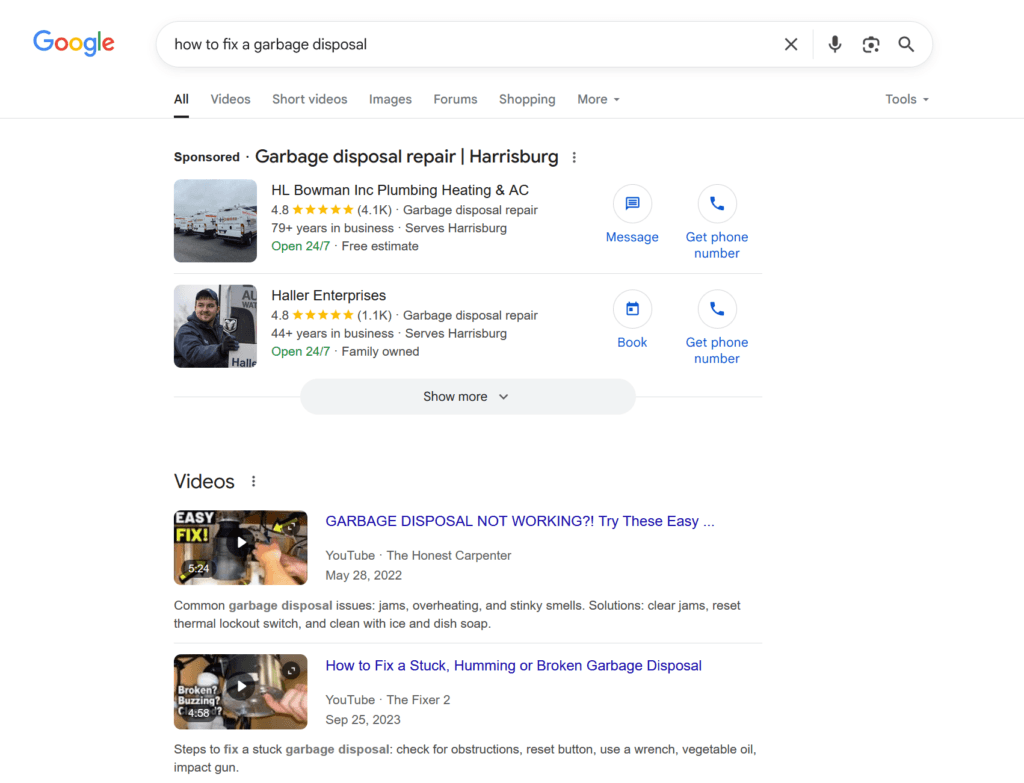
Medium-risk industries include Food & Drink, Home & Garden, Vehicles, and Business & industrial. Search results here often blend informational and visual elements. A query about “how to fix a garbage disposal” needs both explanation and visual confirmation, making it a candidate for AI Overviews but not a guarantee. There are also more direct commercial and navigational queries in these areas, like folks searching for a particular car part or looking up hours that a business is open. As we discussed, those types of queries are less likely to prompt an AI overview response
Lower-risk industries
Arts/Entertainment, Dining/Nightlife, Sports & Fitness, Real Estate, and Apparel make up our lowest risk industries.These verticals depend heavily on visuals, local relevance, or real-time information that AI struggles to replicate effectivel within an AI Overview.
Finally, the health sector deserves special attention. Even single-word medical searches like “eczema” or “chrons” trigger AI Overviews at roughly 50% rates, which is much higher than we see in other industries. Google has always treated healthcare queries with a special lens, given the sensitivity and personal nature. This is true for AI Overviews as they appear far more frequently for health-releated queries than any other industry.
What does it all mean for your business?: Your industry vertical plays a big part in determining your AI Overview risk level. Health and finance marketers face entirely different challenges than retail and restaurant marketers, requiring distinct tactical approaches rather than one-size-fits-all solutions.
The two AI Overview brakes
While certain factors accelerate AI Overview appearance, two specific elements dramatically reduce their likelihood, even for long, informational queries. These “brakes” represent the strongest defensive positions available to marketers facing AI displacement.
Brake #1: Local and brand modifiers provide powerful protection
Adding location or brand terms to a longer query creates remarkable protection against AI Overviews. The data shows how different modifiers affect AI Overview rates for 7+ word queries:
| Modifier present | Sample Query | AI Overview Rate |
| No modifier | “how to choose car insurance deductible amount” | 35.2% |
| Location (“near me”, city, state) | “best pilates studio near me open today” | 9.1% |
| Brand/retailer name | “where can i buy socks at walmart” | 8.7% |
| Local + brand together | “outback steakhouse tampa fl reservations near me” | 6.4% |
The drop is dramatic: A nearly a 30-point drop from 35.2% to 6.4% when both local and brand modifiers are present.
Let’s talk about why. The answer lies in Google’s SERP real estate priorities. When someone searches for local services or brand-specific information, map packs, shopping ads, and branded results push AI Overviews below the fold…or make them go away altogether. Google correctly recognizes that local intent and brand navigation represent different underlying intent than typical informational queries.
Think about the difference in intent for these search queries:
- Generic: “best Italian restaurant dishes” (high AI risk)
- Local: “best Italian restaurant downtown Chicago” (low AI risk)
- Brand + local: “Olive Garden locations near me” (minimal AI risk)
The generic query is more informational and research focused, whereas the other queries contain modifiers that alter the search intent. Google would likely pick a map pack to display for the localized/branded queries in these examples.
This means local SEO and prioritizing placement in Google Maps is still paramount for local businesses with brick and mortar locations. Maybe AI Overviews expand into this territory eventually, but the search experience is likely most helpful to users with maps displaying at the forefront and that’s unlikely to change in the near term.
Brake #2: Visual and commerce niches stay protected
Industries that rely heavily on visual elements, product comparison, or subjective preferences see significantly lower AI Overview rates. Our analysis reveals specific niches where AI Overviews rarely appear:
| Query Archetype | Example | Industry | AIO Rate |
| Long SKU retail searches | “long sleeve rust orange dress with bell cuffs” | Apparel | <10% |
| Local service finders | “plumber near me open now” | Home Services | 8% |
| Brand navigation terms | “ups tracking” | Shipping/Logistics | 6% |
| Local brand navigation | “pizza hut near me” | Dining/Nightlife | 3% |
When these types of queries meet the typical AI Overview criteria (sufficient length, clear intent, popular topics) they remain largely protected from displaying AI Overviews because they require elements that AI text cannot effectively provide.
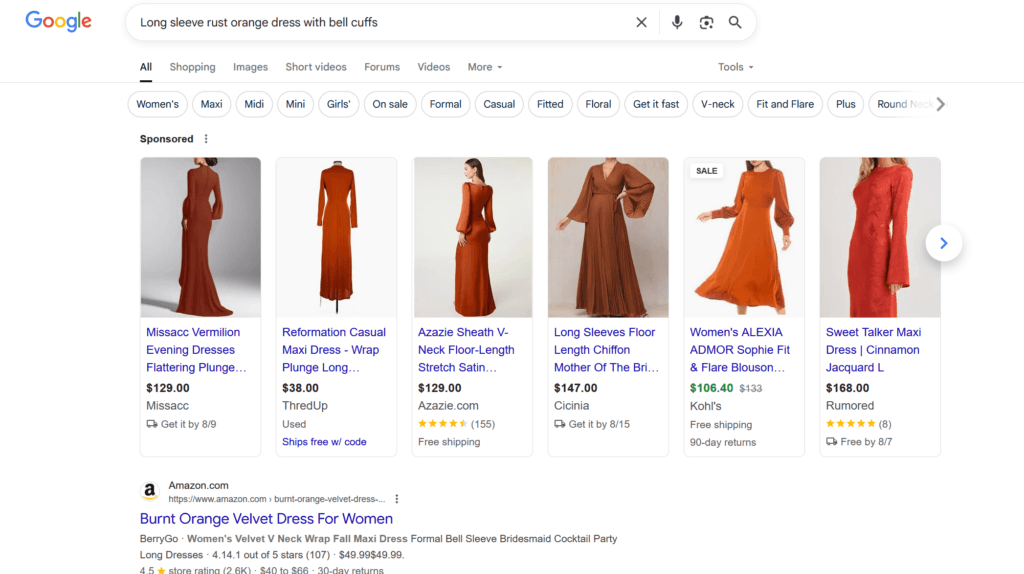
The apparel example is a great one to unpack. “Long sleeve rust orange dress with bell cuffs” is exactly the type of specific, long-tail query that would typically trigger an AI Overview based on length and specificity. But fashion searches require visual confirmation, size availability, price comparison, and brand information. Ultimately, Google feels those are best answered with other SERP elements like Shopping Ads.
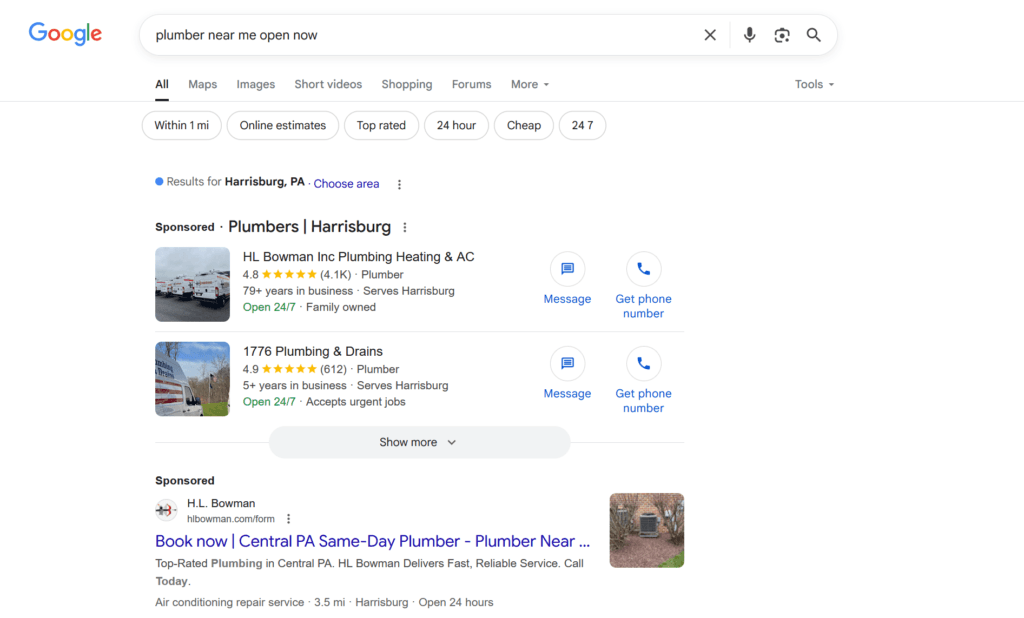
Similarly, local service queries like “plumber near me open now” need real-time availability, location info, and review signals so map packs and local listings provide more effective outputs than AI Overviews.
The more your industry depends on visual decision-making, real-time information, or subjective preferences, the more protected you are from AI Overview displacement. Prioritize rich imagery, structured product data, and visual content formats to maintain this natural protection.
High-risk query patterns: Where AI Overviews dominate
Our analysis identified specific query archetypes that consistently trigger AI Overviews at rates significantly above the 25.8% baseline. Understanding these patterns helps marketers identify their most vulnerable content before traffic drops occur.
The danger zone: High-AI queries
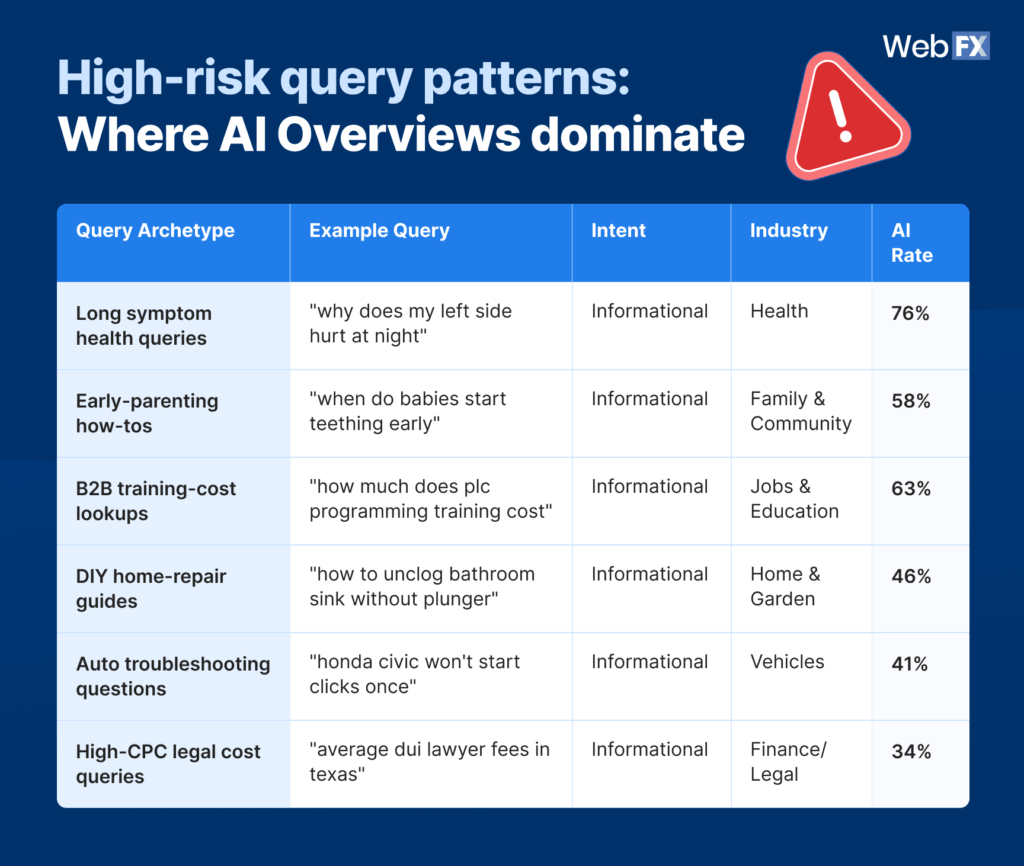
These query patterns reveal Google’s strategy for AI Overview deployment. The highest-risk queries combine multiple accelerating factors: They’re long (6+ words), informational in intent, and from trust-heavy industries where comprehensive explanations add value.
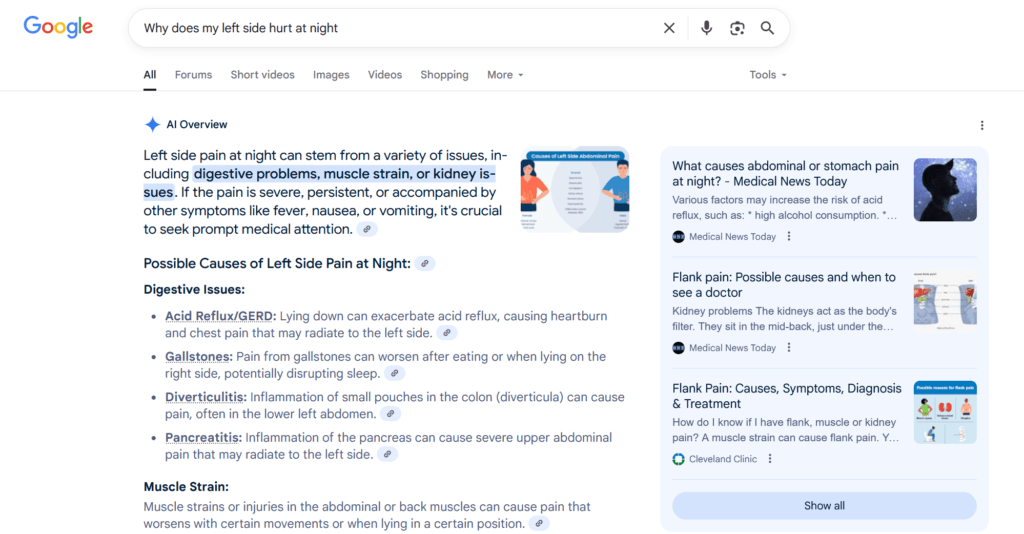
Notice the health queries at the top of the risk spectrum. “Why does my left side hurt at night” represents exactly the type of query where Google wants to provide immediate, authoritative information. Users with health concerns need quick answers, and AI Overviews can synthesize medical information from multiple authoritative sources faster than users can research individual websites.
The B2B training cost queries highlight another vulnerable area. Professional development research (“how much does plc programming training cost”) represents high-intent, high-value searches where businesses make significant investment decisions. AI Overviews can provide cost ranges, comparison factors, and decision frameworks without requiring users to visit multiple training provider websites.
For content marketers, these patterns indicate which types of content face immediate displacement risk. If your content strategy relies heavily on answering detailed how-to questions, providing cost estimates, or explaining complex processes step-by-step, you’re competing directly with Google’s AI Overview priorities.
Safe zone query patterns: Where traditional results dominate
Conversely, certain query types maintain low AI Overview rates even when they meet typical triggering criteria:
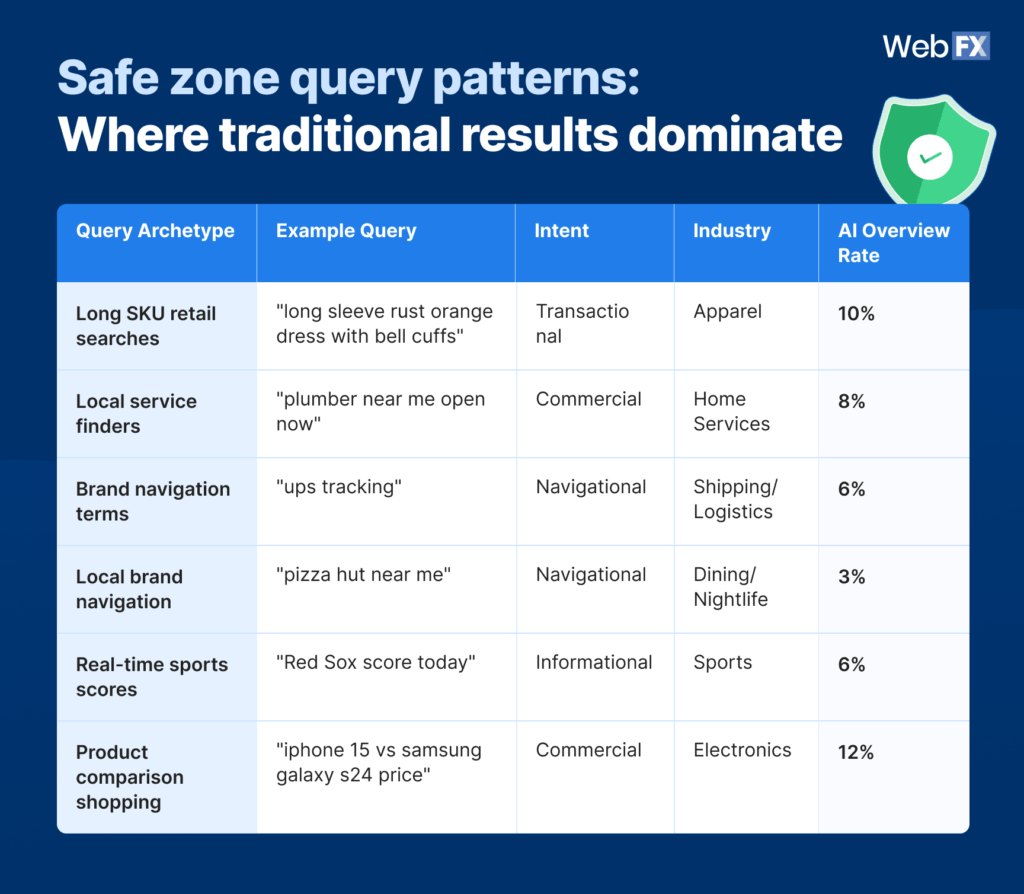
What’s the trend here? These queries often need real-time information or visual results (shopping or maps) to fully answer the searcher’s question.
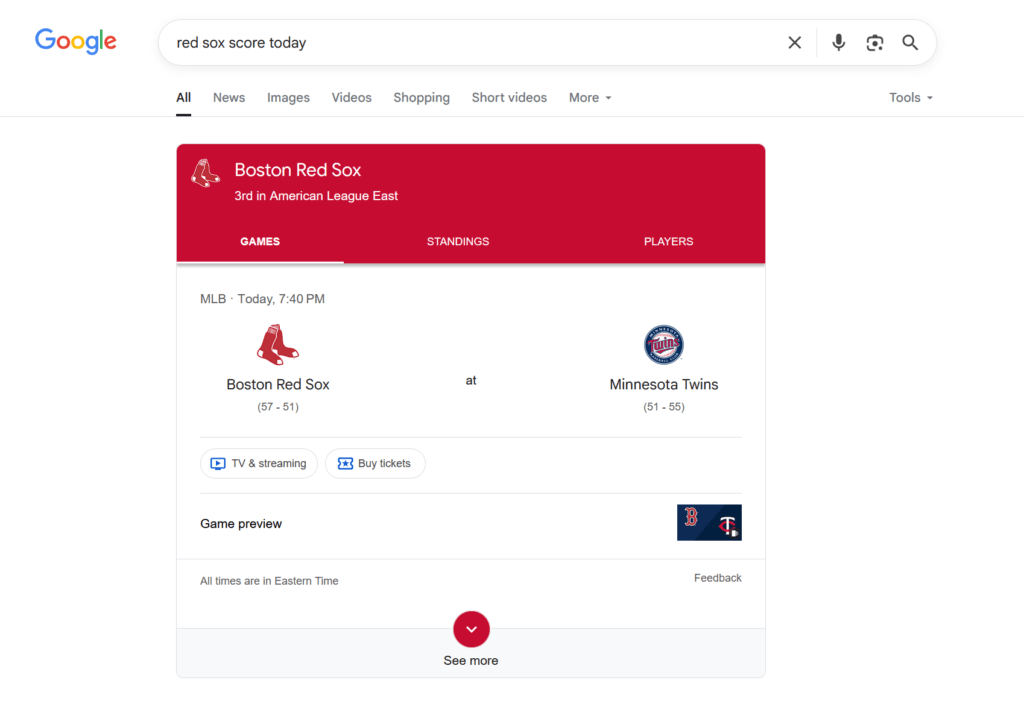
While “Red Sox score today” seeks informational content, it requires real-time data that sports widgets and live score features provide more accurately than AI Overviews. Again, Google is adapting to display what will be most helpful for the searcher in these cases of low AI Overview percentages.
What AI overviews eating your traffic means for your marketing strategy
So what are businesses left to do? What’s the playbook here?
High risk industries face the most change and the biggest challenges ahead, especially health companies. Our data shows that health-related searches trigger AI Overviews in 51.6% of cases overall, with symptom-specific queries reaching 76% AI rates. Finance and education follow similar patterns, making traditional content marketing approaches increasingly challenging.
A few ideas:
Gather data on how your site performs in AI overviews now
We offer a free tool over on SEO.com that shows how visible your website is right now within AI Overviews. It’ll also tell you which sites currently are getting cited the most for keywords that you rank for. It’s a great starting point as you put an action plan together.
Strengthen EEAT signals immediately
Google has a high bar for these types of industries. Generic, broad content doesn’t perform well and likely won’t get elevated as sources in AI Overviews. Focus on expanding your EEAT signals. Make sure your medical content is vetted and reviewed by credible professionals and talk about that on your site. Add trust signals around your content. Work with experts in your organization to involve them in your content process. Update author bios with specific credentials, add professional certifications, link to peer-reviewed sources, and ensure content reflects genuine professional experience.
Implement comprehensive schema markup
Google and other AI tools are increasingly turning to Schema markup as a way to better classify and understand content. So FAQ and HowTo structured data help Google understand your content’s purpose and may increase chances of being referenced as an AI Overview source. But go beyond basic schema. Use MedicalWebPage schema for health content, EducationalOrganization markup for training materials, and FinancialProduct schema for financial guidance. The goal is making your content easily machine-readable for AI systems.
Develop hybrid content strategies
The harsh reality is it is going to be tougher than ever to drive substantial organic search traffic into written, informational content in these high risk industries. Again, this raises the bar for content creation. Aside from generic written content, what can you do to elevate and expand your content strategy. You could lean into more interactive content elements: videos, tools, personal assessments. These are things that can’t be answered and interacted with in an AI overview. A health symptom checker tool provides more value than an article explaining symptoms that AI can summarize.
Consider paid coverage for must-win terms
Not an option that content marketers want to think about, but a short term pivot shifting more budget to paid for top performing informational content may make sense. If key pieces of informational content have helped drive visitors into your marketing and sales funnels effectively over the years, you’re likely to see similar results driving targeted paid traffic into those pages. Cost on informational related keywords in networks like Google Ads is much cheaper than heavy commercial terms so you may be able to replace some of your organic traffic decline with highly targeted users via paid channels for less money than you think.
Implications for SEO as a marketing channel
AI Overviews appearing for ¼ of searches signals fundamental changes in how users will interact with Google in the future. Doubly so with more users turning to conversational search queries, which show more AI Overviews. These trends present a challenge for businesses and marketers as clear trends emerge:
From traffic capture to authority building: The shift toward AI Overviews rewards sites that become authoritative sources for AI systems rather than destinations for direct user visits. This changes content ROI calculations and success metrics in ways most marketing teams haven’t yet fully considered.
From keyword targeting to topic authority: Individual keyword optimization becomes less valuable than comprehensive topic coverage that establishes subject-matter expertise. AI systems draw from authoritative topic clusters rather than single-page optimizations.
From content creation to content curation: The emphasis shifts toward curating and organizing information in ways that AI systems can easily access and reference, rather than creating standalone content pieces designed solely for human consumption.
From search ranking to search citation: Success metrics have long been tied to keyword rankings in the SEO world. Nowadays, thinking about it more as brand visibility may be more effective. There’s less traffic to go around and one of the new battlegrounds is trying to get your business cited in rich results like AI Overviews.
Only Google knows what lies ahead for search results in 2026 and beyond. But businesses that are able to succeed at the core of SEO – satisfying user intent and providing helpful information – are likely to be the winners in the new AI era of search. That doesn’t mean winners can expect exponential growth in informational search traffic, those days are likely gone. But visibility in all forms still matters to businesses and being listed in AI Overviews and places like ChatGPT is going to draw a lot of interest over the next few years.
Methodology and data considerations
We looked at 2,371,151 keywords everything from single words to full questions, across tons of different industries. Basically, we wanted to see the full picture of when Google decides to show AI Overviews. We looked at one word queries and we also looked at 16 word queries like “how to build a raised garden bed out of recycled shipping pallets step by step instructions.”
A few things to keep in mind:
Google keeps tweaking this stuff. What we’re seeing in July 2025 might look different next month. The exact percentages will probably shift, but the overall patterns? Those should stick around for a while.
Intent can be tricky to measure. Is “best diy solar panel kits prices” an informational query or a commercial one? There are elements of both. In this case, we classified as commercial because of the price element but certainly room for interpretation.
This is all US data. Google has been aggressively rolling out more AI Overviews in other markets but we looked exclusively at the US results.
-
 Trevin serves as the VP of Marketing at WebFX. He has worked on over 450 marketing campaigns and has been building websites for over 25 years. His work has been featured by Search Engine Land, USA Today, Fast Company and Inc. Read his review of working with WebFX for the last 15 years.
Trevin serves as the VP of Marketing at WebFX. He has worked on over 450 marketing campaigns and has been building websites for over 25 years. His work has been featured by Search Engine Land, USA Today, Fast Company and Inc. Read his review of working with WebFX for the last 15 years. -

WebFX is a full-service marketing agency with 1,100+ client reviews and a 4.9-star rating on Clutch! Find out how our expert team and revenue-accelerating tech can drive results for you! Learn more
Try our free Marketing Calculator
Craft a tailored online marketing strategy! Utilize our free Internet marketing calculator for a custom plan based on your location, reach, timeframe, and budget.
Plan Your Marketing Budget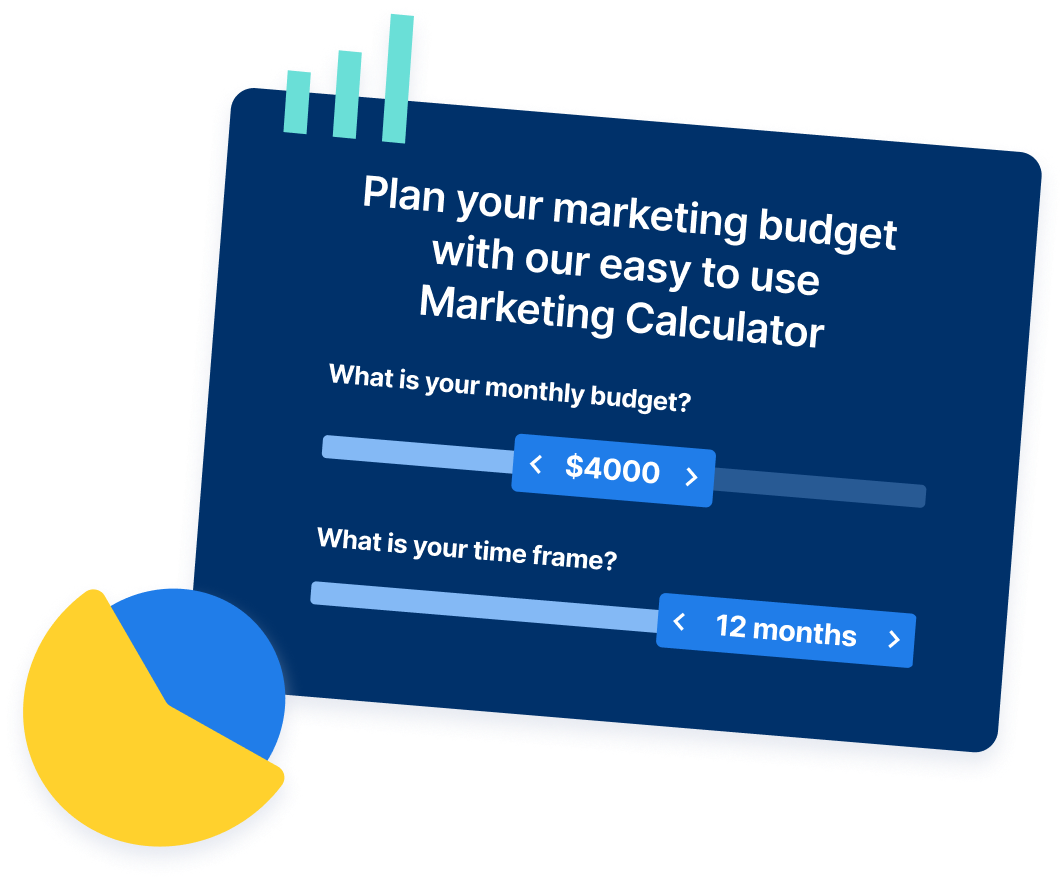
Table of Contents
- The three AI Overview accelerators
- The two AI Overview brakes
- High-risk query patterns: Where AI Overviews dominate
- Safe zone query patterns: Where traditional results dominate
- What AI overviews eating your traffic means for your marketing strategy
- Implications for SEO as a marketing channel
- Methodology and data considerations

SEO Success with KOA

Proven Marketing Strategies
Try our free Marketing Calculator
Craft a tailored online marketing strategy! Utilize our free Internet marketing calculator for a custom plan based on your location, reach, timeframe, and budget.
Plan Your Marketing Budget
What to read next




